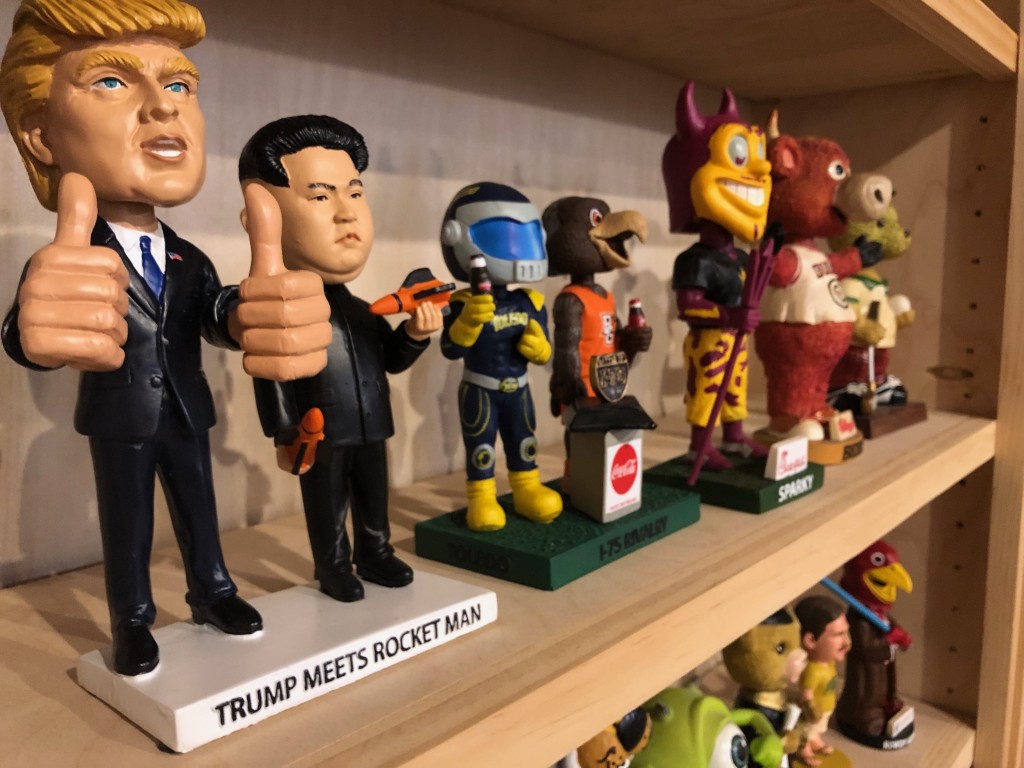What’s Shaking at the Bobblehead Hall of Fame
MILWAUKEE–Phil Sklar once had a successful career in corporate finance.
He was assistant finance director for the $500 million Engineered Solutions Segment at Actuant Corporation in Menomonee Falls, Wis. One day he quit his job to become co-founder and CEO of the National Bobblehead Hall of Fame and Museum, which opened February 1 in Milwaukee.
I bet heads spun at that exit interview.
Sklar, 35, and museum co-founder Brad Novak, also 35, have known each other since middle school in Rockford, Ill. Another huge bobblehead collector, Novak left a career in retail sales for a cell phone company to start the museum.
During a humid early July afternoon, Sklar walked through the hollowed halls of 6,500 bobbleheads in the museum, nestled at 170 S. 1st St. in Milwaukee’s historic Third Ward. The collection starts at 10,000 unique bobbleheads. And counting.
Sklar explained, “I was working for another company for five years and they wanted me to move to the east coast for a promotion. I didn’t want to leave Milwaukee. I was just finishing my MBA (at Northwestern University’s Kellogg School of Management) in Chicago.”
Sklar also has a Masters of Science in Accountancy degree from the University of Notre Dame and a Bachelor of Science in Finance from the University of Wisconsin-Milwaukee.
Sklar and Novak shared a condo in Milwaukee. Novak began gathering bobbleheads in 2002 as a member of the Rockford RiverHawks staff from baseball’s independent Frontier League. Sklar said, “We were already collecting these. So I went to this other company (Actuant) and that’s where the idea came up. The bobbleheads were getting out of control. They were creeping into the kitchen of our condo. We had to do something about it.
“We found a niche in the production side of making bobbleheads and you put the two ideas (not heads) together and come up with a hall of fame for bobbleheads. There’s nothing else like this in the world.” Sklar said they still have about 1,000 bobbleheads in their home and they’re always coming up with new ideas. Just last week they rolled out a commemorative “Chance the Snapper” alligator bobblehead to honor the dearly departed media darling from Chicago’s Humboldt Park. The seven-inch bobblehead features a moving head and tail.
The 4,000-square feet museum is neatly organized by categories: Baseball, basketball, football, hockey, pop culture, (Three Stooges, Wizard of Oz, Star Wars, etc.), mascots, (lots of the rotund Mr. Met), NASCAR and more. Admission is just $5. There’s also a gift shop with nearly 500 unique bobbleheads for sale.
The Bobblehead Museum and Hall of Fame has attracted lots of families.
Not so many single women.
I probably have about 250 bobbleheads, including the Kane County Cougars Dontrelle Willis “bobble leg” and the Charleston River Dogs Bill Veeck “bobble leg.” Also known as nodders or wobblers, two Two bobbles are in my kitchen: a cocktail server bobblehead from Pat O’Brien’s in New Orleans and the Iowa State Fair “bobble cow.” I’d guess about 90 percent of my collection comes from actually attending events as opposed to buying them off of eBay.
I live alone.
“Our collection started at about 3,000,” Sklar said. “We went to a lot of games. We didn’t go to 3,000 but we went to hundreds of games. We also travel to major league baseball stadiums. We’re now at 27. So if we go to Cincinnati, we get bobbleheads at antique stores or the team store.” Sklar and Novak know of hard to find bobbleheads. A 14-inch New York Yankees bobble circa 1960-61 just sold for under $60,000. It was a limited release used to promote bobbleheads in store windows and was available only in the New York area.
I thought I knew a lot about bobbleheads.
But I didn’t know they date back to 1765. Sklar pointed to a framed painting and said, “Most people are surprised to see this painting of Queen Charlotte (1744-1818) in her dressing room at
Buckingham Palace with two figurines behind her. Their heads are on spring mechanisms that make them bobble.” I leaned into the painting and squinted. Of course, there was no way to tell if the figurines bobbled, but hey, it is a great story.
“One reason we started the museum was that there was no central spot to find out this information,” Sklar said. “No one knew the history. There’s misinformation. People said the first basketball bobblehead was in 1920 with the New York Knicks. But there was no New York Knicks in 1920.”
The museum contains the first bobblehead stadium give away, a Willie Mays model that commemorated the final season at San Francisco’s Candlestick Park in 1999. Sklar looked at the Say-Hey Kid and said, “This is what brought bobbleheads back into prominence. Up until that point you purchased bobbleheads at games.
Entrepreneurship runs in the Sklar family. His father and grandfather owned and operated a big and tall clothing store in Rockford for more than 50 years. His mother worked in various retail jobs. Her father owned and operated a corner store in their hometown of Sioux City, Ia. for roughly 50 years. This DNA is likely why the museum is so well organized.
An impressive collection of Chicago Cubs bobbleheads greets visitors as part of the “Regional” section. “It laid out nicely with the regional bobbleheads leading into the local,” Sklar explained. “As
our other co-founder is also from Rockford, we’re both Cubs fans. I’m Bears, he’s Packers. Lots of Chicago fans love this.” He peeked around a corner and said, “The White Sox are sort of hidden over there.” An entire Wisconsin section even includes the Midwest League’s Timber Rattlers from Appleton.
A rotating Wall of Champions area features current MLB, NFL, NHL, and NBA champion team member bobbleheads. I was surprised that most of the bobbleheads are not in glass cases. The daring visitor could stick out a finger to make the museum piece bobble. That’s like tickling the Mona Lisa to make her smile.
“We have the most valuable ones and older ones behind glass,” Sklar said. “We’re still thinking about (glass cases) but everybody has been good. It makes it more accessible. You don’t touch them. A lot of them bobble as you walk by. We’re also looking at mechanisms for perpetual bobbling. (A device that makes a case bobble.) Since we only opened February 1, we’re taking it step by step.”
A 1964 set of Beatles “BOBB’N HEAD” bobbleheads are displayed in a glass case. The moptops are nattily dressed in suits and ties. “Those are a centerpiece of the collection,” Sklar said. The Beatles are in a 1960s area with kissing bobbleheads and Santa and Mrs. Claus bobbleheads.
During my visit, a couple of kids were walking around with a pen and clipboards. That seemed intense. “We have scavenger hunts for kids and adults,” Sklar explained. “We have a ‘Where’s Waldo’ bobblehead and they have to find it.”
There are at least three bobbleheads visitors will not find:
Michael Jordan playing basketball.
Oprah Winfrey. And Muhammad Ali.
“We get the Michael Jordan question a lot,” Sklar said. “It’s licensing. There have been a couple of unlicensed Jordan bobbleheads. We do have an unauthorized Birmingham Barons Jordan bobblehead. Oprah has been pitched to her people but she didn’t go for it. If she ran for president that would be easy because you can do candidates.” The museum plans to expand its political section for July 2020 when Milwaukee hosts the Democratic National Convention.
A wall-sized bulletin board asks visitors for bobblehead suggestions. Notes posted on my visit were: Ru Paul, Jerry Garica, Spice Girls, Women’s Soccer and more. Near the bulletin board, bobbleheads of Dr. Martin Luther King, Nelson Mandela, and Wisconsin’s own Liberace are predominately displayed.
Don’t miss the section of bobbleheads produced at the National Bobblehead Museum. They have manufactured nearly 1,000 bobbleheads. The first one was for Michael Poll, a friend, Special Olympian since 1985 and Milwaukee super fan. The second was a screaming bobblehead to honor long- time Cubs fan Ronnie “Woo Woo” Wickers.
The museum plans to manufacture 32 Negro League alumni in conjunction with the 100th anniversary of the Negro National League. You can buy Satchel Paige, Cool Papa Bell, Monte Irvin and others. The museum is also manufacturing an Effa Manley bobblehead, the only female to be inducted into the Baseball Hall of Fame. Manley (1897-1981) owned the Negro Leagues Newark Eagles franchise. The series is licensed by the Negro Leagues Baseball Museum and a portion of sales proceeds will go to relatives of the players. The bobbles retail for $30 at the museum and an extra $8 for shipping.
The museum also rolled out a bobblehead for Marian Catholic High School’s Sister Mary Jo Sobieck, who threw out a colorful first pitch at an August, 2018 White Sox game. “She’s sort of the counterpart to Sister Jean,” Sklar said of the Loyola University superfan. Sister Jean is the museum’s biggest seller with more than 18,000 bobbleheads sold.
One of the most popular limited- edition releases is a talking bobble of Cubs announcer Pat Hughes calling the final out of the 2016 World Series. The first run with Hughes in a blue shirt sold out the day it was released. A redshirt version was released on Nov. 2, 2018, the second anniversary of the Cubs World Series championship. Both versions were numbered up to 2,016. “He’s been great to work with,” Sklar said. “It took a couple of years to get that one done.”
Don’t miss the bobble of an empty-handed Cubs manager Joe Maddon celebrating “The Curse is Over!” That bobblehead was produced by FOCO. “He was holding a goat in that (left) hand, but MLB nixed it,” Sklar said. “They cut the goat out.” The museum was one of a limited number of retail partners that carried the bobblehead.
Sklar and Novak even created their own National Bobblehead Day, which is now every January 7. And the good news is they also commissioned a bobblehead theme song from long-time Milwaukee singer-songwriter Pat McCurdy.
The bad news is that the song’s repetition makes it sound sort of like the “Kars for Kids” radio commercial. A panel of the museum is even devoted to McCurdy, with, of course, his bobblehead.
It would be impossible to not connect with your inner child at this museum. “Teenagers see characters and players they love, older people see serial characters from growing up that brings back a lot of memories,” Sklar said. “It does appeal to all generations. The springy head and fun movement just make people smile.” Sklar said with a nod.








Leave a Response